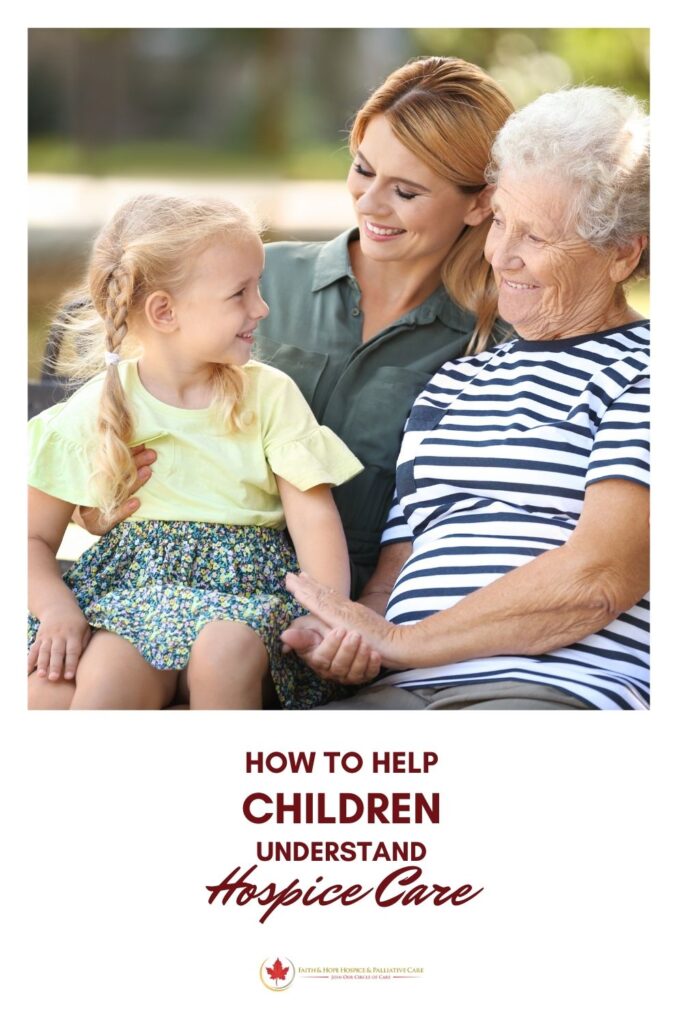
Explaining Los Angeles palliative care can be a significant challenge for parents, especially if the child in question is not old enough to fully comprehend the concept of dying. According to Yale University Child Study Center, children develop a gradual understanding of death between the age of 5 and 7. Many children may struggle to comprehend that some illnesses cannot be cured and that death is permanent. They may be confused, angry, or sad about their loved one having to be placed in hospice care. Babies who can not yet communicate can also sense when the parent is in significant distress, resulting in behavioral changes. Fortunately, there is help available for you. You can learn how you can help your young children understand hospice care by following these tips:

You can provide your child with a safe space to express what they already know about the situation at hand. Allow them to ask any questions they may have about the person who is or is about to be admitted into Los Angeles hospice, as well.
Many of us may delay telling children the truth simply because we are unsure how to present the issue correctly. We also may feel that “sheltering” them is the best way to go about it. Explain the situation in simple terms: “Grandma is sick and she needs people to take care of her.” When talking about death, do not refer to it as “going to sleep” or “going away.” This may further entertain a child’s “magical thinking” and will prevent the child from understanding that the person in question is not coming back. They may even think that there is something they can do to change the outcome when there clearly is not.
Your child may express the desire to visit your loved one in Los Angeles hospice care. Allow them to have that closure with them. This is especially important if the patient has played an active role in a child’s life. Depending on the illness that the individual has, you may need to explain the condition to the child so that they are not frightened or surprised by it. For example, a patient with dementia may have a difficult time recollecting important events or even remembering who the child is. Use age-appropriate language to help the child understand the disease.
It is normal to feel unsure about how to talk to children when the family is going through difficult times. Because each child is different, they will not respond to these challenges exactly the same. You may benefit from talking to your child’s pediatrician or other child development expert on how to help your child during this trying time. After the death has occurred, have the child partake in our bereavement and grief support program. Faith and Hope offers in-person and phone counseling for both individuals and families. The transition to a new normal is rough for anybody, but it can help the child to know that their feelings are normal and nothing to be ashamed of. You can also take them to our annual patient memorial.
Our Los Angeles hospice and palliative care team is committed to your loved one’s highest quality of comfort and safety. Please call our toll-free number at (877) 797-1977 today if you have a relative who is in need of hospice care.
Faith and Hope Hospice
We firmly believe that the internet should be available and accessible to anyone, and are committed to providing a website that is accessible to the widest possible audience, regardless of circumstance and ability.
To fulfill this, we aim to adhere as strictly as possible to the World Wide Web Consortium’s (W3C) Web Content Accessibility Guidelines 2.1 (WCAG 2.1) at the AA level. These guidelines explain how to make web content accessible to people with a wide array of disabilities. Complying with those guidelines helps us ensure that the website is accessible to all people: blind people, people with motor impairments, visual impairment, cognitive disabilities, and more.
This website utilizes various technologies that are meant to make it as accessible as possible at all times. We utilize an accessibility interface that allows persons with specific disabilities to adjust the website’s UI (user interface) and design it to their personal needs.
Additionally, the website utilizes an AI-based application that runs in the background and optimizes its accessibility level constantly. This application remediates the website’s HTML, adapts Its functionality and behavior for screen-readers used by the blind users, and for keyboard functions used by individuals with motor impairments.
If you’ve found a malfunction or have ideas for improvement, we’ll be happy to hear from you. You can reach out to the website’s operators by using the following email
Our website implements the ARIA attributes (Accessible Rich Internet Applications) technique, alongside various different behavioral changes, to ensure blind users visiting with screen-readers are able to read, comprehend, and enjoy the website’s functions. As soon as a user with a screen-reader enters your site, they immediately receive a prompt to enter the Screen-Reader Profile so they can browse and operate your site effectively. Here’s how our website covers some of the most important screen-reader requirements, alongside console screenshots of code examples:
Screen-reader optimization: we run a background process that learns the website’s components from top to bottom, to ensure ongoing compliance even when updating the website. In this process, we provide screen-readers with meaningful data using the ARIA set of attributes. For example, we provide accurate form labels; descriptions for actionable icons (social media icons, search icons, cart icons, etc.); validation guidance for form inputs; element roles such as buttons, menus, modal dialogues (popups), and others. Additionally, the background process scans all the website’s images and provides an accurate and meaningful image-object-recognition-based description as an ALT (alternate text) tag for images that are not described. It will also extract texts that are embedded within the image, using an OCR (optical character recognition) technology. To turn on screen-reader adjustments at any time, users need only to press the Alt+1 keyboard combination. Screen-reader users also get automatic announcements to turn the Screen-reader mode on as soon as they enter the website.
These adjustments are compatible with all popular screen readers, including JAWS and NVDA.
Keyboard navigation optimization: The background process also adjusts the website’s HTML, and adds various behaviors using JavaScript code to make the website operable by the keyboard. This includes the ability to navigate the website using the Tab and Shift+Tab keys, operate dropdowns with the arrow keys, close them with Esc, trigger buttons and links using the Enter key, navigate between radio and checkbox elements using the arrow keys, and fill them in with the Spacebar or Enter key.Additionally, keyboard users will find quick-navigation and content-skip menus, available at any time by clicking Alt+1, or as the first elements of the site while navigating with the keyboard. The background process also handles triggered popups by moving the keyboard focus towards them as soon as they appear, and not allow the focus drift outside it.
Users can also use shortcuts such as “M” (menus), “H” (headings), “F” (forms), “B” (buttons), and “G” (graphics) to jump to specific elements.
We aim to support the widest array of browsers and assistive technologies as possible, so our users can choose the best fitting tools for them, with as few limitations as possible. Therefore, we have worked very hard to be able to support all major systems that comprise over 95% of the user market share including Google Chrome, Mozilla Firefox, Apple Safari, Opera and Microsoft Edge, JAWS and NVDA (screen readers).
Despite our very best efforts to allow anybody to adjust the website to their needs. There may still be pages or sections that are not fully accessible, are in the process of becoming accessible, or are lacking an adequate technological solution to make them accessible. Still, we are continually improving our accessibility, adding, updating and improving its options and features, and developing and adopting new technologies. All this is meant to reach the optimal level of accessibility, following technological advancements. For any assistance, please reach out to
